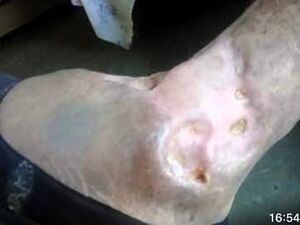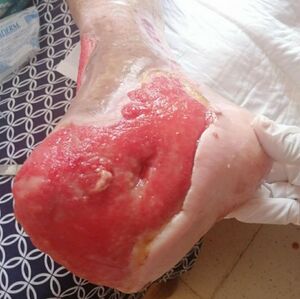Severe partially amputated diabetes foot
Case Report:
Successful Management of a Partially Amputated Foot in an Elderly Patient Using Chlorine Dioxide Solution (CDS)
Abstract:

This case report describes an unprecedented recovery following the application of Chlorine Dioxide Solution (CDS) in an elderly female patient with a partially amputated foot. The patient, who initially faced the prospect of further amputation, opted for alternative treatment with CDS, resulting in significant healing and improved mobility. This case highlights the potential of CDS in managing diabetic foot conditions and calls for further investigation into its therapeutic benefits.

Introduction:
Diabetic foot complications often lead to severe outcomes, including amputations, which significantly impact patient quality of life. Traditional treatments may not always yield favorable results, prompting exploration of alternative therapies. This report presents the case of an elderly woman who chose to utilize CDS following medical recommendations avoiding additional amputation.
Case Presentation:

The patient, an elderly female with a history of diabetes, presented with a partially amputated foot due to complications associated with her condition. After thorough evaluation, the medical team recommended another amputation to prevent further complications. However, the patient and her family declined this option, opting instead for a trial of CDS.
The treatment protocol included repeated footbaths and adherence to Protocol C and Protocol D throughout the day. The patient underwent this treatment regimen consistently over several weeks.

Results:
Remarkably, the patient's foot demonstrated never observed progressive healing, with reduced inflammation and improved tissue integrity. After a sustained period of treatment with CDS, she regained sufficient mobility to walk slowly without assistance. No adverse effects were reported during the course of treatment.
Discussion:

This case represents a significant departure from conventional approaches to diabetic foot management and highlights the potential role of CDS as a therapeutic agent. The observed recovery suggests that CDS may facilitate healing in chronic wounds where traditional methods have failed.
Conclusion:
The successful outcome in this case warrants further research into the efficacy and safety of Chlorine Dioxide Solution for diabetic foot ulcers. Given the growing prevalence of diabetes and associated complications, exploring innovative treatment options could reduce unnecessary amputations and enhance patient outcomes worldwide.
Keywords: Chlorine Dioxide Solution, diabetic foot, amputation, wound healing, case report.
